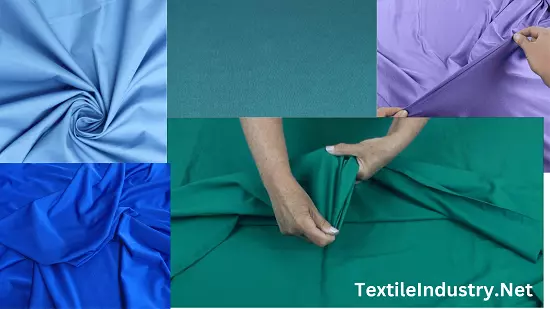One of the most notable features of Lycra Fabric is its outstanding elasticity. This fabric can stretch up to five times its original length, providing exceptional freedom of movement and a comfortable fit. It’s this elasticity that has made Lycra fabric a popular choice in a wide array of clothing items, ensuring they adapt to the body’s movements without losing their shape. In this article, we present What is Lycra Fabric: Its Characteristics, Uses, Care and Maintenance instructions.
What is Lycra Fabric?
Lycra introduced to the world this synthetic fiber that could stretch up to six times its original length and snap back to its original form without losing its integrity. This invention revolutionized the textile industry, bringing forth a new era of comfort and flexibility in clothing.
Characteristics of Lycra Fabric
Lycra’s claim to fame is undoubtedly its remarkable stretchability. It is the guru of fabrics, capable of stretching, flexing, and returning to its original form with ease. This makes it an invaluable component in a plethora of garments, from sportswear that needs to accommodate a wide range of motion, to form-fitting fashion pieces that hug the body just right.
Lycra is also incredibly durable. It stands up to repeated wear and washing, maintaining its shape and integrity over time. This resilience makes it a cost-effective choice for both clothing manufacturers and consumers, as garments that incorporate Lycra tend to have a longer lifespan than those without.
Beyond its physical capabilities, Lycra shines in the comfort department. It feels smooth against the skin, reducing friction and preventing chafing. This is especially important in activewear, where comfort is paramount, but it’s also a cherished quality in everyday clothing. With Lycra, you can move freely and comfortably, regardless of what your day entails.
Common Uses of Lycra Fabric
1. Sportswear and Activewear
In the realm of physical activity, Lycra is indispensable. It’s a game-changer for athletes and fitness fans, ensuring clothes move with the body, and offering support without restriction. Its resilience to wear and tear, alongside frequent washes, makes it a reliable choice for sportswear. For high-performance athletic wear, you might prefer Lycra as it is known for its durable and high-stretch qualities, providing support and flexibility during intense activities.
2. Swimwear
For swimming enthusiasts, Lycra is a go-to. It dries quickly, resists chlorine, and maintains a snug fit, reducing drag in the water and ensuring your swimsuit remains in top shape, swim after swim. Lycra is resistant to chlorine and saltwater, making it a popular choice for swimwear. However, Lycra is particularly renowned for maintaining its shape and durability even with frequent exposure to harsh pool chemicals
3. Undergarments
In the undergarment sector, Lycra Fabric is so important, providing a seamless and smooth fit, whether it’s in your daily underwear or in shapewear. It stays put, offers comfort, and gives a sleek silhouette, all while being so lightweight, you’ll barely notice it’s there.
4. Fashion and Casual Wear:
For everyday wear or fashion items, Lycra blend Fabric is more cost-effective and still offers the comfort and stretch you need. Generally, Lycra blends with Cotton and Polyester in Fashion and Causal wear.

Care and Maintenance of Lycra Garments
To ensure the longevity and performance of your Lycra garments, proper care is crucial. Here’s how you can maintain them. Wash Lycra items in cold water. Hot water can break down the fibers and cause the fabric to lose its elasticity. Use a mild detergent and avoid bleach as it can damage the Spandex fibers. Fabric softeners can leave a coating on Lycra that breaks down the fibers over time. Lay your Lycra garments flat to air dry, or hang them up to dry.
Avoid wringing them out as this can damage the fibers. If you must use a dryer, use the lowest heat setting. High temperatures can cause Lycra to lose its stretch. If possible, hang Lycra garments to prevent creasing. If you must fold them, do so gently and avoid placing heavy items on top. Prolonged exposure to direct sunlight can break down Spandex fibers, so it’s best to store your garments in a cool, dry place. By following these care guidelines, you can help ensure that your Lycra garments maintain their shape, elasticity, and performance for as long as possible.
So maintaining Lycra garments is straightforward, ensuring they last longer and stay in good condition. Keep Lycra away from high heat. Opt for cold washes and air drying. This preserves the fabric’s elasticity and prevents potential damage. Stick to gentle detergents to maintain the fabric’s integrity. Harsh chemicals can break down the fibers, shortening the garment’s lifespan. Try to dry your Lycra garments away from direct sunlight to prevent UV damage over time. If you’ve worn Lycra swimwear, rinse it in cold water afterward to remove chlorine or salt, which can harm the fibers if left unchecked. By following these care tips, your garments should stay in excellent condition, offering stretch.
Conclusion
In summary, when choosing Lycra Fabric, consider your specific needs, the intended use of the fabric, the required care, and your budget. This fabric offers unique benefits, and understanding these aspects will help you make a decision that suits your preferences and requirements. By taking the time to understand the unique characteristics of each option, you can make an informed decision that aligns with your requirements, ensuring satisfaction and optimal performance from your chosen material.
- You may love to read: What is Spandex: Physical and Chemical properties ||| Uses of Spandex
- Differences Between Lycra and Spandex
